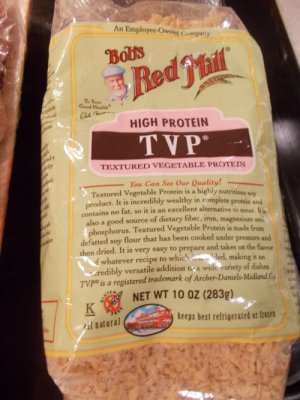Dehydrated Ground Beef
Hunting deer and squirrels to add meat to your meals is a lot of work. Assuming it’s even legal to hunt animals, then you have to catch something. And even if you catch something, you’ll have to skin it, clean it and cook it. There’s a better way of adding a little meat to your meals in the backcountry—dehydrated ground beef. It rehydrates remarkably well!
You can add ground beef to just about any meal: burritos, tacos, spaghetti, Hamburger Helper and more! The catch for most people is how to dehydrate it in the first place. We’ll show you the step-by-step directions here.
Preparing the Ground Beef
Step 1: Buy Ground Beef
Get your ground beef. I like to buy large packs of it from Costco like this 7.41 lb. block of meat. Since we’ll be dehydrating it, it can last for months! So make a lot—enough to last you for at least a month or two. No reason to dehydrate ground beef every week if you can do it a few of times each year instead.
Get the meat with the lowest fat content you can find. Fat is the first thing that will spoil, dehydrated or otherwise, and the less of it in your meat, the longer it’ll last before spoiling.
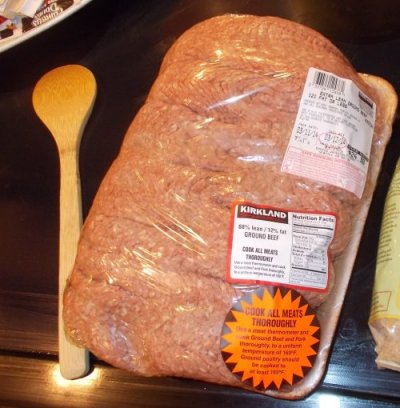
Step 2: Cook the Ground Beef
Cook your ground beef like you normally would. You won’t be cooking ground beef on the trail (just rehydrating it), so it needs to already be cooked.
If you add seasonings to your ground beef, you can do that as well—but I typically add seasonings while rehydrating the ground beef so I can use the ground beef for many different types of meals and add seasonings to suit the meal.
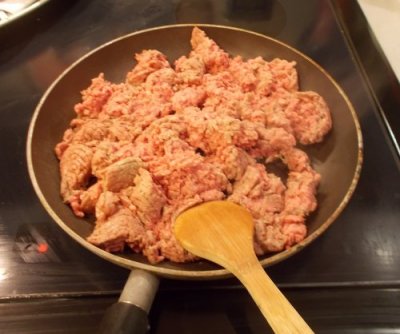
Step 3: Drain the Fat
Drain the fat. Drain every last drop of it you can. Fat will spoil your dehydrated ground beef faster than anything else and the more you can squeeze out of it, the longer it will last. If you have a strainer, by all means use it, but I usually just pour it out into an old cottage cheese cup.
One of my readers suggested that after draining the fat, pour a cup or two of boiling water over it to remove even more grease. Admittedly, I haven’t done this myself, but there’s no reason not to. The more of the fat you can get rid of, the better!
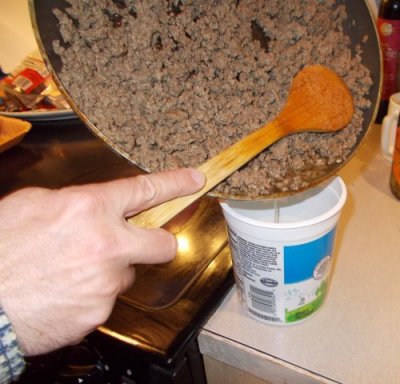
Step 4: Setup Dehydrator
Ideally, you’ll have a dehydrator, but you’ll also find directions for how to dehydrate food with an oven online. If you dehydrate often, though, I highly recommend a dedicated dehydrator. And to dehydrate in bulk, you’ll definitely want a few extra trays and solid inserts. (I have eight that I can fire up at once for my dehydrating needs.)
Be sure to use the solid, plastic inserts so the ground beef doesn’t slip through the cracks to the bottom of the dehydrator. Using a cooking spray like Pam isn’t necessary. The residual fat in the ground beef will make sure the meat doesn’t stick to the tray.
Spread the ground beef out evenly, not more than a quarter-inch or so thick. If you can’t see the tray at all through the ground beef, it’s probably too thick.
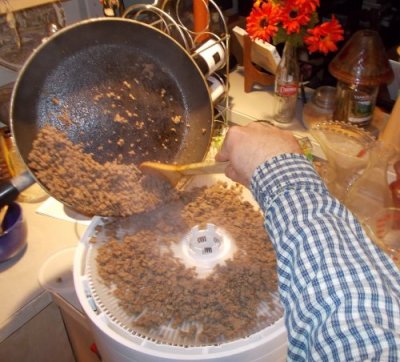
Step 5: Dehydrate the Ground Beef
Now turn on the dehydrator to 145°F (65°C) and leave it running for 6 to 8 hours. I typically cook this right before going to sleep then check it when I wake up in the morning.
You’ll see a lot more of the tray as the ground beef shrinks in the dehydrator. Pay particular attention to the larger pieces of ground beef—those are the ones that take longest to dehydrate. Break the larger pieces open and make sure it’s dehydrated all the way through. The shell of each piece becomes somewhat brittle, tougher and darker—and might even scratch your skin if you try. The center should look dry.
If you aren’t sure if your ground beef is done, go ahead and keep the dehydrator going since it’s all but impossible to dehydrate ground beef too much—if it runs for 10 or 12 hours, no harm done.
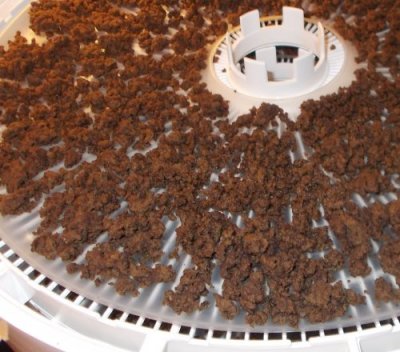
Step 6: Package the Dehydrated Ground Beef
After your ground beef has cooled, scoop it into ZipLoc bags and store it in your refrigerator until it’s time to use on your next backcountry adventure.
I don’t really know what the shelf life is for this. I’ve regularly eaten it six months after preparing it with no ill effects, and I’ve carried it unrefrigerated for over a month without any ill effects; so I like to tell people it’s good for six months with refrigeration and six weeks without refrigeration.
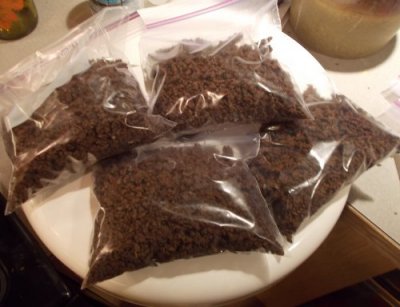
Cooking with Dehydrated Ground Beef
Dehydrated ground beef will rehydrate completely after 5 to 10 minutes in boiling water. I’ll usually add it to whatever I’m normally cooking at the very beginning and let my food simmer for 10 to 15 minutes which is more than adequate for rehydrating the ground beef.
Another thing I’ll usually do is add some Textured Vegetable Protein (TVP) to my ground beef. Most of my diet in the backcountry doesn’t have much protein in it, and I can’t really taste the TVP, so I’ll mix it in with my ground beef in the Ziplock bags and use that.
